Index


Review: Powerful and Silent
Our guest today is Gaiwnard GTX 560 Ti Phantom. The card is a part of Gainward’s Phantom line, aimed at those who like their cooling effective but silent. GTX 580 and GTX 570 already received Gainward’s Phantom treatment, so we guess it’s expected to see the GTX 560 Ti get the same remake.
Although our card comes with 1GB of GDDR5 memory, Gainward also offers a 2048MB version. We thought that testing the 1024MB versions will probably be wiser as 2GB cards tend to be pricier while not justifying the price difference on the gaming front.
Gainward GTX 560 Ti Phantom 1GB stands at €234, whereas Gainward GTX 560 Ti Phantom 2GB comes at €350, here.
Note that the 2GB version runs at reference clocks, whereas the 1GB version comes factory overclocked. However, the overclock is relatively small as you can see from the GPUZ shot below.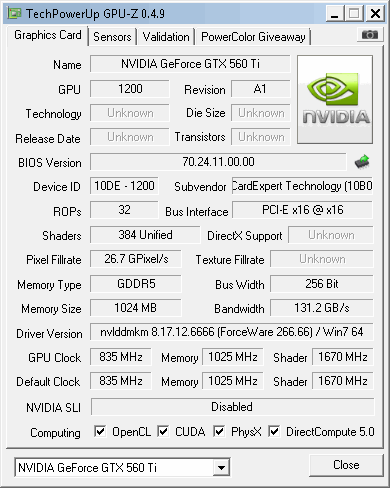
Nvidia set GTX 560 Ti reference clocks pretty high compared to the rest of Fermi cards. Namely, GPU runs at 822MHz, shaders at 1644MHz and the memory at 4008MHz. When the card is idle, the clocks go pretty low – 50.6MHz for the GPU, 101MHz for shaders and 67.5MHz for the memory.
The GTX 560 Ti’s ticker is the GF114 GPU, which received plenty of positive acclaim so far and we’ve seen that the card boasts nice performance-per-clock ratio as well.
Before we move on to the card, let us remind you that the GF114 is a derivation of GF104, as is evident from the number of transistors (1.95 billion). However, the GF114 packs a few improvements inherited from the GF110.

Gainward GTX 560 Ti Phantom is almost 19cm long, compared to the reference 22,9cm (9 inches). However, Gainward’s card is wider – Phantom cooling is 2.5 slots wide whereas the reference card is two slots wide.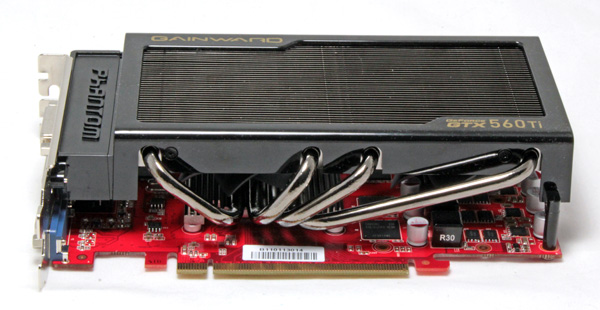
Phantom cooler comes with 4 heatpipes and two 80mm fans. The fans are placed inside the large heatsink so a glance at the card would suggest that the card is passively cooled. The fans are very quiet so we guess there would be no harm in assuming that.
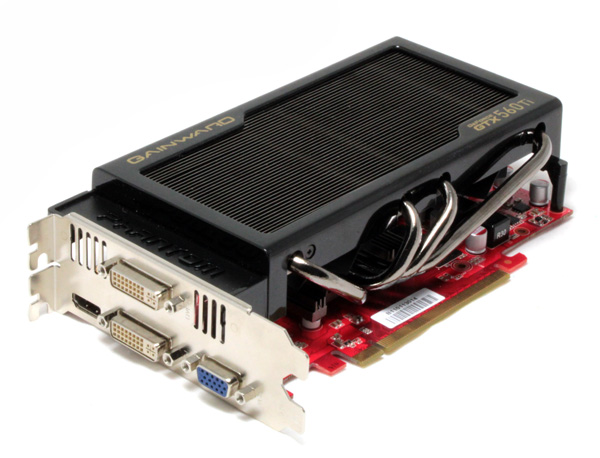
As far as video outs go, we have here the classic Gainward’s Quattro-ports design, i.e. two dual link DVIs, HDMI and VGA out. Note that only two video outs can be used simultaneously. Nvidia included an HDMI sound device within the GPU, so there is no need for connecting the card to your motherboard’s/soundcard’s SPDIF out to get audio and video via HDMI.
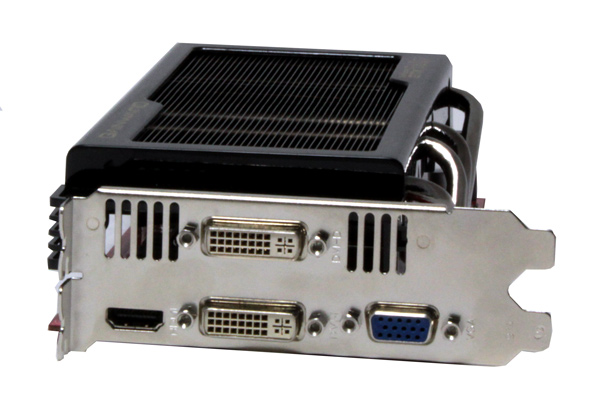
GTX 560 TI comes with one SLI connector. This means you can combine up to two GTX 560 Ti cards in SLI mode for improved performance or image quality settings.
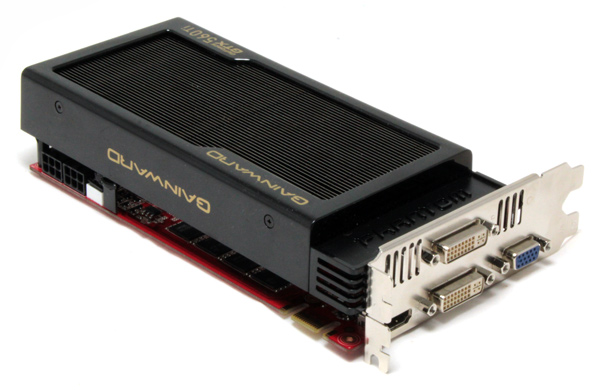
The Gainward Geforce GTX 560 Ti Phantom uses 1024 MB video memory. The chips used are K4G10325FE-HC04 parts from Samsung. They are specified to run at 1250 MHz (5000 MHz GDDR5 effective).
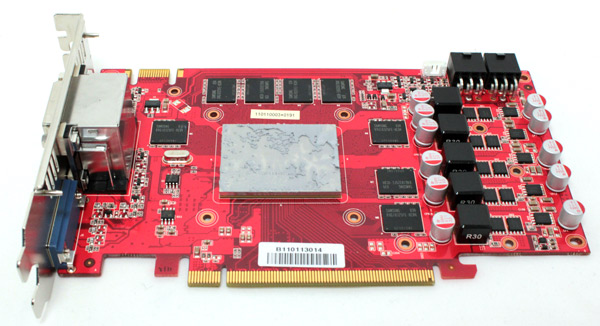
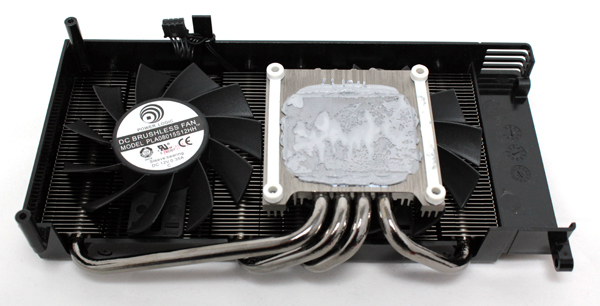
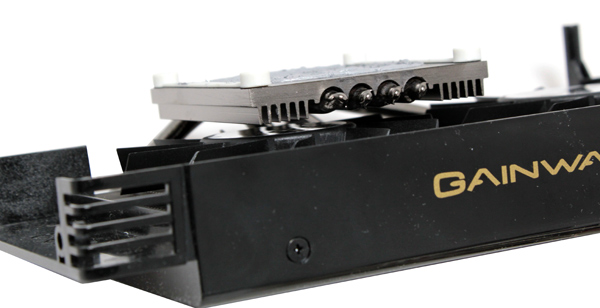
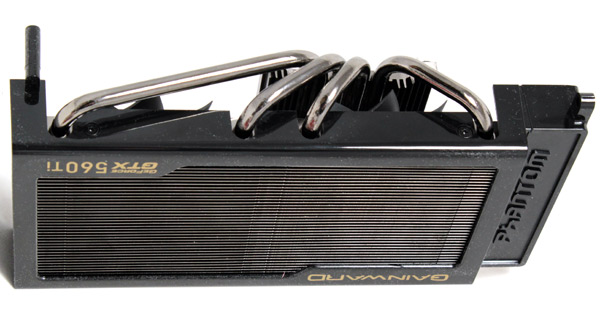
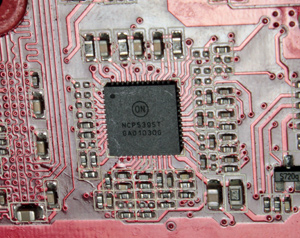
OnSemi's NCP5395T is a cost-effective voltage regulator. It does not offer I2C voltage control, but a VID based control is available through API in NVIDIA's driver.

The card has two 6-pin PCI-Express power connectors.
Packaging
The GTX 560 Ti Phantom’s packaging is similar to that of GTX 580 Phantom cards, only smaller. As you can see from the picture below, the larger box (GTX 580) says Phantom 3, meaning three fans. Our GTX 560 Ti Phantom comes with two fans.
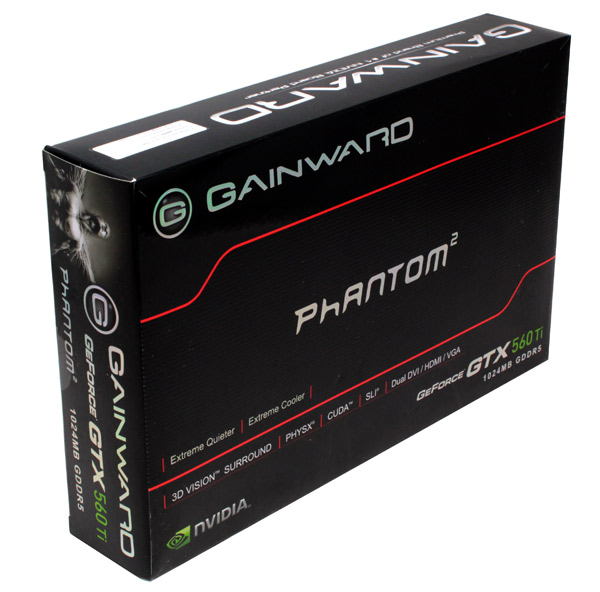
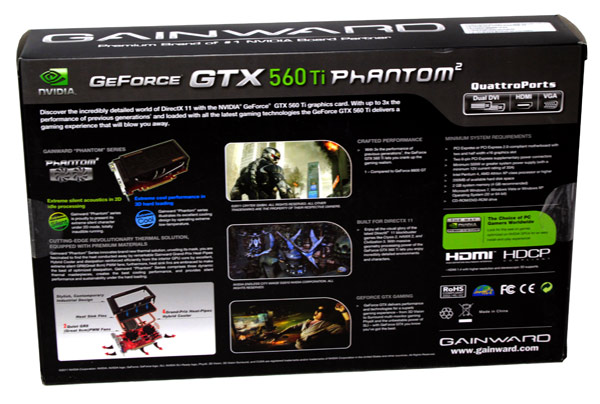
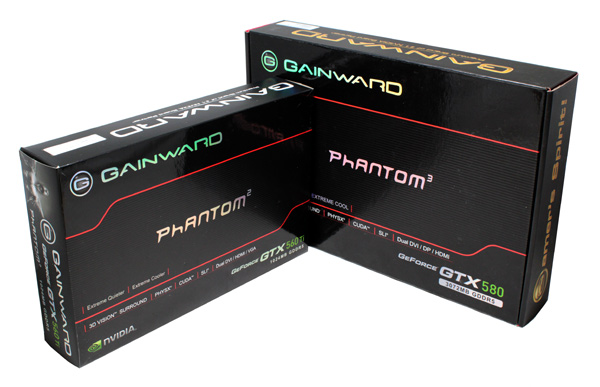

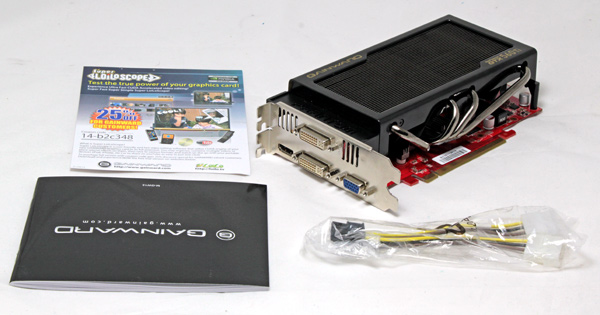
Testbed
Motherboard: EVGA 4xSLI
CPU: Core i7 965 XE (Intel EIST and Vdrop enabled)
Memory: 6GB Corsair Dominator 12800 7-7-7-24
Harddisk: OCZ Vertex 2 100 GB
Power Supply: CoolerMaster Silent Pro Gold 800W
Case: CoolerMaster HAF X
Fan Controler: Kaze Master Pro 5.25"
Operating System: Win7 64-bit
266.66_desktop_win7_winvista_64bit
11.1 CCC
3Dmark 2011 / Vantage
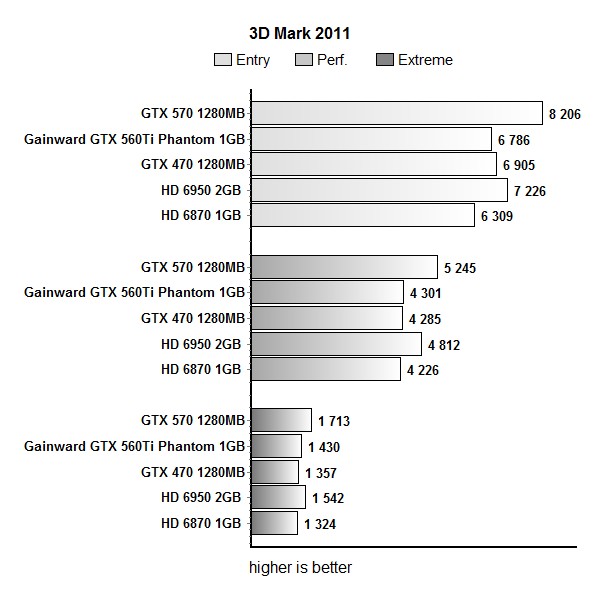

Aliens vs Predator
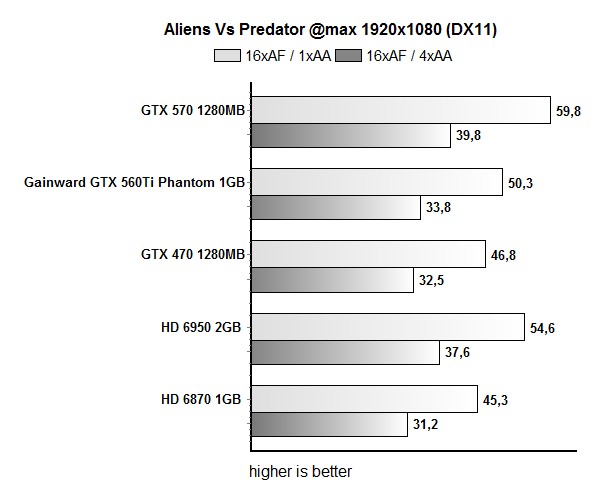
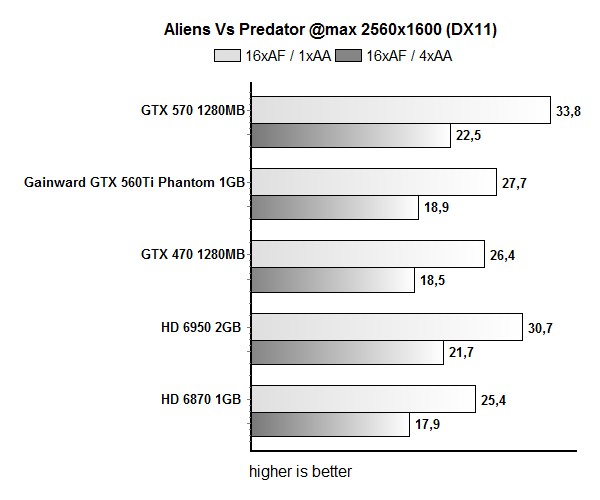
Dirt 2
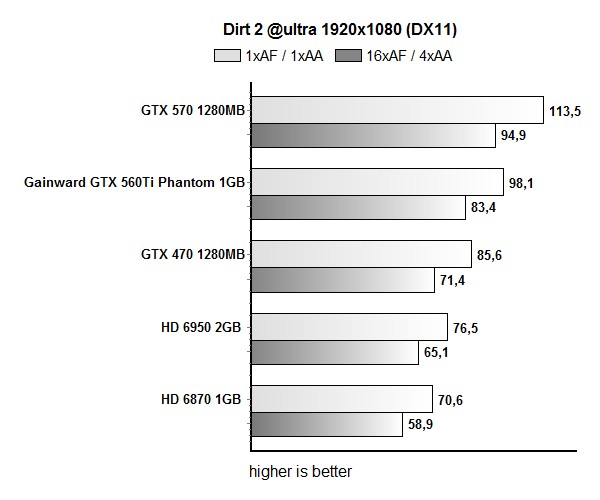
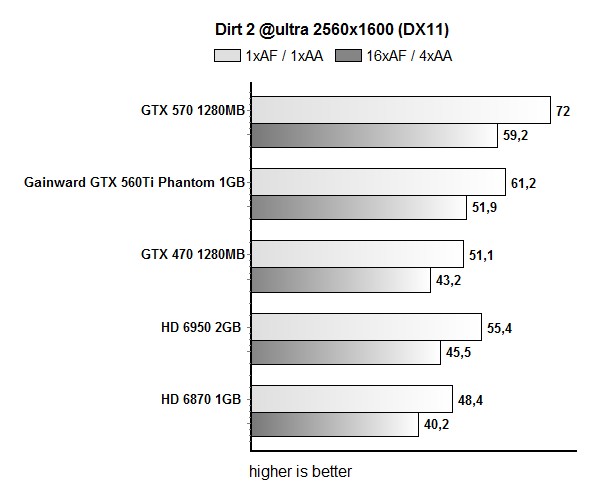
Metro 2033

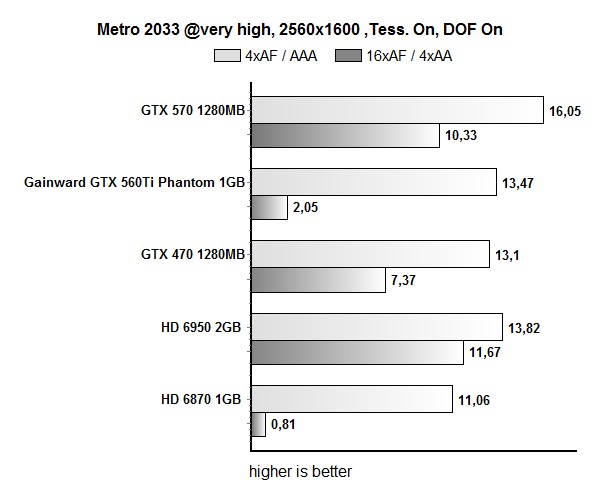
Unigine Heaven: Tessellation
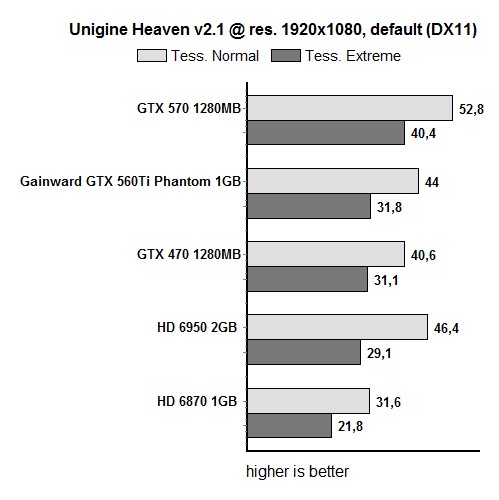
Overclocking
Overclocking the GF114 should not be a problem, regardless of whether it’s reference or specially designed GTX 560 Ti. Most GTX 560 cards will run stable at 920+MHz. Gainward’s cooling provides a nice foundation for a healthy overclock and we got to following results. We managed to push the GPU from 835MHz to 930MHz, and the card remained quiet throughout. 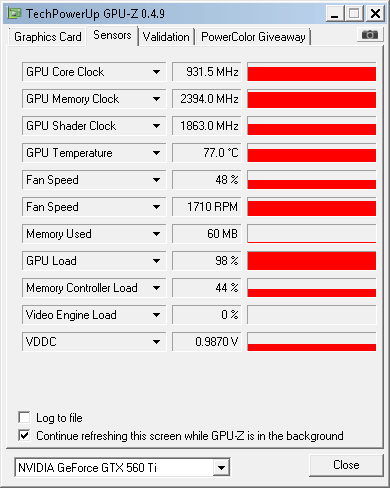
Thermals and Noise
As far as noise levels go, the GTX 560 Phantom’s cooler is almost inaudible when idle, with GPU temperature around 33°C. The GTX 560 Phantom is almost inaudible during operation too. In our case, intensive 3D resulted in GPU temperature of about 73°C.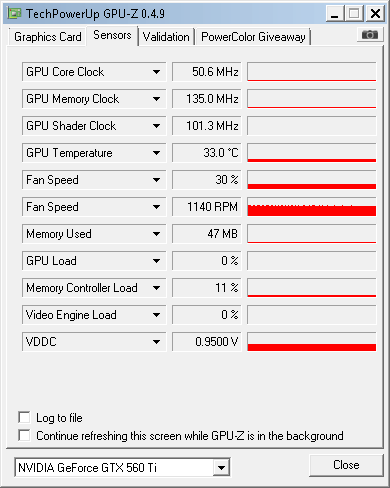


Consumption
Nvidia Geforce GTX 560 Ti provides nice performance, on many occasions comparable to those of the HD 6950 2GB. While AMD’s HD 6950 consumes about 20W less during gaming, the GTX 560 Ti consumes some 4W less when both cards are idle.
Nvidia added Advanced Power Management on all cards in the GTX 500 series, a feature which monitors consumption and performs power capping – all to protect the graphics cards from excessive power draw and potential damage. When the sensors detect higher than allowed consumption, the GTX 560 automatically downclocks and reverts to original clocks when the overcurrent is over.
GTX 560 Phantom 1GB’s GPU runs at 835MHz; the shaders are at 1670MHz whereas the memory runs at 4100MHz. When idle, the card downclocks to 50.6MHz for the GPU, 101MHz for shaders and 135MHz for the memory.
Conclusion
By launching the GTX 560 Ti, Nvidia finally sent the GTX 470 to its resting grounds. GTX 560 Ti is efficient, packs a mean punch and we believe it will do well, at least for one season.
Good thermals and overclocking potential caught an eye of many a partner and many of them have launched special versions of the card on day one. One model is definitely leading the pack for now – Gainward’s GTX 560 Ti Phantom. As the name suggests, it is a card from Gainward’s Phantom family, which as of now has three cards – GTX 580, GTX 570 and GTX 560 Ti. All three of these cards come with Phantom cooling, which is efficient and quiet.
GTX 560 Ti Phantom can beat the HD 6950 2GB in some games, provided you are gaming up to 1920x1600. As soon as you switch to 2560x1600, you’ll see the HD 6950 2GB reclaim the pole position. All in all, GTX 560 Ti’s price/performance ratio is pretty good and Gainward’s Phantom version is not much pricier than the reference card. Gainward’s virtually inaudible cooling would surely justify the higher price, and you can find the card here at €233, here. The card also comes with full size HDMI, which many will appreciate, and it is also 4cm shorter compared to the reference design.
In short - Gainward’s GTX 560 Ti Phantom offers gaming at all resolutions, it won’t cause power-bill headache and the card remains silent regardless of the workload.



